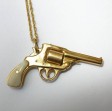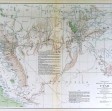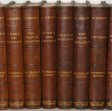Great Western Single Actions – The First Modern Replicas
By: John Taffin, aka Sixgunner
The 1950’s had to be just about the greatest time ever for growing up. We were not disadvantaged with 150-channel TVs, cell phones, VCRs, computers, electronic games, or adults who thought they had to coach us so we could play football and baseball. Outside was for continuous activity; inside was for eating and sleeping. Mom still stayed home and cooked three meals a day, seven days a week. We never had to go out to eat. Until McDonalds restaurants started, I didn’t know of anyone that ever went “out to eat.”
We did have one great disadvantage, and it is the only one I can think of, which was a lack of information available on firearms. There were no gun magazines in the early 1950’s. The outdoor magazines rarely published anything about handguns; in fact, the only magazine that did, and certainly not often enough, was the American Rifleman. Paperback books started to show up from publishers such as Trend, and for 75 cents one could have “The Complete Book of Handguns.” And even though it was complete, a new copy came out every year.
Then it happened. It was the dead of winter, late December, 1954, and I had gone downtown to see a movie, a western of course, and stopped in at the newsstand. There it was. I had to blink to make sure it was real. I know my heart skipped a beat, maybe two. There on the rack was a new magazine called GUNS, and it was dated January 1955. I was a junior in high school and reading every book I could find about guns and hunting, and I made frequent trips to town just to check out the newsstands for any gun publications. My search for knowledge had been rewarded. GUNS was only the first magazine, and over the next few years it would be followed by Guns & Ammo (which began as a quarterly), Gun World, and Shooting Times (which began life as a newspaper).
During the first year of publication, GUNS carried an article entitled “A Six-Shooter For TV Cowboys.” Westerns on TV were the rage in the 1950’s, starting with old B Westerns, which evolved into made-for-TV Westerns. This created a demand for single-actions, not only to be used by the actors, but by shooters as well. Colt had ceased production of the Single Action Army in 1941. Since they had publicly declared that they had no plans to ever resurrect the old Peacemaker, the prices on pre-war Single Action Colts started to rise.
Now that Westerns had created a demand for single-actions (as much as Clint Eastwood’s Dirty Harry would do 20 years later for Smith & Wesson .44 Magnums), someone had to fill it. First came the Single-Six. Bill Ruger had been very successful with his relatively inexpensively priced semi-automatic .22 in 1949, and in 1953 he came back with a .22 single-action. Everything but the grip frame, which was nearly identical to the old Colt Single Action Army, was scaled-down to make it an easy-handling, virtually unbreakable single-action chambered in a caliber that everyone could afford to shoot. As with just about every other kid at that time, my first handgun was a Ruger Single-Six. What wonderful times we had shooting .22 Marlin leverguns and Ruger Single-Sixes.
Meanwhile, at the other end of the country, another gun company was founded, Great Western Arms Co. of Los Angeles. Shooters wanted real Colts and they couldn’t get them, but Great Western stepped in to fill the void. That article in GUNS was about Great Westerns. The Great Western looked so much like a Colt Single Action Army that they actuallyused real Colts in the early advertising. I’m not sure exactly when Great Western began, but I think I saw the first ads in 1954 when I was a junior in high school. They were smart enough to present John Wayne with an early matched pair, fully-engraved with ivory grips. One of the owners of the company was Audie Murphy. Young Murphy lied about his age to get into World War II, became the most decorated hero of that conflict, and then went on to make Western movies. Some thought that he wasn’t much of an actor, but we didn’t care. He was a real genuine hero who could definitely handle a Colt Single Action .45 on the silver screen.
In the late 1950’s, I bought my first Great Western Single Action. I had great luck with the Single-Six .22, so I purchased a Great Western .22. That turned out to be a mistake. The 5-½” .22 proved to be a really poor shooting sixgun, and was definitely out of time. Thirty-five years later, I picked up two more 5-½” Great Western .22s, which have proven to be excellent shooters and are also favorites with the grandkids. In fact, the grandkids and I were just out yesterday morning shooting the guns, and we saved enough money shooting the .22s that I was able to fill them up with a late breakfast at The Cracker Barrel after we finished shooting.
Elmer Keith, in the first chapter of his book Sixguns by Keith (1955), commented that the test Great Western Single Action that he had received was “…very poorly timed, fitted, and showed a total lack of final inspection. The hand was a trifle short, the bolt spring did not have enough bend to lock the bolt with any certainty, the mainspring was twice as strong as necessary, and the trigger pull was about three times as heavy as needed.”
I think the same guy made his test gun and my .22. Later in his book, Elmer was able to say, “We are happy to report that Great Western has really gotten on the ball, and is now cooking on all four burners. They overhauled their designed and inspection departments, put in some gunsmiths who knew the score, and are now turning out first-class single-action copies. We have one in 4-¾” .44 Special, and it is a very fine single action in every way, perfectly timed, sighted, and very accurate. It has performed perfectly with factory loads and our heavy hand loads, and is very accurate at extreme ranges, the real test of any sixgun.”
The Great Western Company was originally owned by a man named Bill Wilson. These guns were totally American-made, and are not to be confused with the Hawes Single Actions, which came later. Hy Hunter was an early distributor of Great Westerns, as was EMF, and he also later brought in the German-made J.P. Sauer & Sohn Hawes versions. I have no idea how many Great Western Single Actions were manufactured in the less than 10 years they were in business. It was not unusual to find them at bargain prices 10 years ago, however the prices have tripled and even quadrupled since then. They are also not all that commonly found at gun shows.
At first glance, Great Western Single Actions look identical to Colt Single Actions with subtle differences in the hammer profile and shape of the trigger guard. They show up on many TV Westerns, and are easy to spot when the hammer is cocked. Colts have the firing pin on the hammer, while Great Westerns have a frame-mounted firing pin, such as that introduced by the old Christy Gun Works and picked up by Bill Ruger for use in all of his single-actions. Unlike the Rugers, the Great Westerns have sort of an upside-down L-shaped hammer.
Great Westerns were made in the three standard barrel lengths: 4-¾”, 5-½”, and 7-½,” plus a 12-½” Buntline Special. The standard model was a 5-½” .45 Colt that sold for $99.50 in 1960. There was a slight additional charge for other calibers and barrel lengths. In addition to .45 Colt and .22, the Great Western was offered in .38 Special, .44 Special, .357 Magnum, .357 Atomic, and .44 Magnum. The “Atomic” was simply a heavily-loaded .357 Magnum and, believe it or not, the .44 Magnum was on the standard Colt-sized mainframe. I have heard rumors to the effect that a .44-40 was also offered, and I do know that they did make some examples chambered in a .22 Hornet.
Great Western also offered both pearl and ivory grips, engraving, nickel-plating, and even the installation of adjustable target sights. The Deputy Model was a 4″ barreled version with a full-length barrel rib, adjustable sights, deluxe blue finish, and walnut stocks instead of the standard issue B-Western-type imitation stags. The Deputy was offered in .22, .38 Special, and .357 Magnum, and also rumored to be in .44 Special.
The Great Western not only arrived at the time that the TV Western was king, but it also profited by the fast draw sport that arose. For those that participated, Great Western offered a specially-tuned 4-¾” barrel .45 with a brass backstrap and trigger guard. It was popular enough that they soon offered a “Professional Fast Draw Model” in all calibers and barrel lengths. A copy of the Remington Double-Barrel Derringer was also offered, chambered in either .38 S&W or .38 Special. The Great Western Cap-n-Ball Revolver looked much like the Old Army that came from Ruger in the early 70’s, but without the top strap.
Most of the parts of the Great Western Single Action are interchangeable with the Colt Single Action Army, except for the hammer, and the hammer, trigger, and bolt screws. The threads on these three screws were changed to help prevent them from loosening as the gun was fired. Two years after the Great Western was introduced, Colt brought back the Single Action Army and, no matter how good the quality had become, Great Western’s fate was sealed. In their advertising, Great Western gave 14 reasons for selecting their single-action instead of another:
1) Great Westerns are made of 4130 Chrome Molybdenum steel, the same as used for stress parts in aircraft and guided missiles.
2) Barrels are made of medium carbon steel of the finest quality overseen by the man formerly in charge of manufacturing Weatherby barrels.
3) Cylinders are made of SAE 4140 Chrome Molybdenum steel heat-treated to a tensile strength of 185,000 pounds per square inch. We have run .45 overloads at 100,000 pounds per square inch.
4) Both the bolt and trigger have been improved over the original and are guaranteed for 20 years, and a frame-mounted firing pin is used.
5) Stocks are imitations stag and are warp-resistant.
6) Late model actions are carefully fitted and assembled with the smoothest and softest actions ever incorporated into a single-action revolver.
7) Mainsprings have been designed for easier cocking.
8) The sear-and-bolt spring, which often failed in original guns, has been specially heat-treated and guaranteed for 50,000 movements.
9) There are no aluminum cast parts.
10) We offer a larger variety of finish including mirror blue, case-hardened frame, chrome, nickel, gold, silver, or combinations thereof.
11) Great Westerns are the only single-actions offered in a variety of barrel lengths.
12) Great Westerns are the only single-actions offered in all popular calibers.
13) Front sights are purposely tall to allow for individual sighting in, and adjustable sights are also available.
14) The hammer is made of SAE 6150 Chrome Vanadium steel, giving greater strength and wear resistance than any other.
Of course, much of the above is advertising hype, however, I have shot approximately one dozen Great Westerns over the past 40 years, and I have never had a spring fail or a part break. I cannot say that about Colt Single Actions or current replicas. I have purchased Great Westerns with broken parts, whether this was from use or abuse I do not know, but one .44 Magnum had a broken firing pin (cost $7.50 to fix) and a chrome 4-¾” barrel .45 Colt was found with a split forcing cone. I replaced the barrel with a Colt barrel. Even though the price has gone up on Great Westerns, they can still usually be picked up for less than the retail price of an Italian-made replica. The problem, of course, is locating one.
John Taffin, aka Sixgunner, SASS #7517, NCOWS #177, The Shootists #1
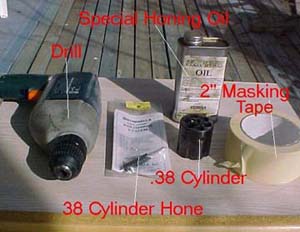 It is time for another issue and another task on our Cowboy Smithin’ six-shooter series. We have looked at some of the things that we do to these sixgun cylinders, and there is one last task that can help a great deal when loading and unloading your hog leg. As a rule, honing the chambers can help most of these old timers. As you know, I like to chamfer the chamber entry way, but after that we use a hone from Brownells and add some special oil to it, it makes the inside of the chambers as smooth as this old gunfighter’s head! These hones are not too expensive, and if you order the special oil when you purchase the hone, you will have a lifetime supply for you and your saddle pals. I always tape up the cylinder with some 2-inch masking tape to keep it from being scratched, and then I use the rubber conveyor belt inserts in my smithin’ vice. I clamp the cylinder in the vice, and then get out the variable speed, portable electric drill and install the hone in the chuck. First, I dunk the hone in the oil, and then run the hone in and out of each chamber to get the inside oiled up. Then, with an up and down movement, I get the drill up to full speed while moving the hone in and out of the chambers. I use about a slow 15 count on each chamber, and when I am done, I flush out the chambers with any kind of cleaner I have on hand. Next, I take the tape off. Remember to keep the chambers oiled with lightweight, non-invasive gun oil. I like the spray cans of Rem-Oil. Well, good job cowboy! Those cartridges should go in great now, just as if they were greased! They will also come out a lot easier, too.
It is time for another issue and another task on our Cowboy Smithin’ six-shooter series. We have looked at some of the things that we do to these sixgun cylinders, and there is one last task that can help a great deal when loading and unloading your hog leg. As a rule, honing the chambers can help most of these old timers. As you know, I like to chamfer the chamber entry way, but after that we use a hone from Brownells and add some special oil to it, it makes the inside of the chambers as smooth as this old gunfighter’s head! These hones are not too expensive, and if you order the special oil when you purchase the hone, you will have a lifetime supply for you and your saddle pals. I always tape up the cylinder with some 2-inch masking tape to keep it from being scratched, and then I use the rubber conveyor belt inserts in my smithin’ vice. I clamp the cylinder in the vice, and then get out the variable speed, portable electric drill and install the hone in the chuck. First, I dunk the hone in the oil, and then run the hone in and out of each chamber to get the inside oiled up. Then, with an up and down movement, I get the drill up to full speed while moving the hone in and out of the chambers. I use about a slow 15 count on each chamber, and when I am done, I flush out the chambers with any kind of cleaner I have on hand. Next, I take the tape off. Remember to keep the chambers oiled with lightweight, non-invasive gun oil. I like the spray cans of Rem-Oil. Well, good job cowboy! Those cartridges should go in great now, just as if they were greased! They will also come out a lot easier, too.
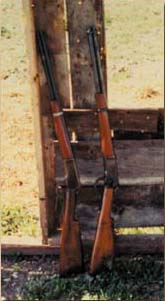
 In 1866, the U.S. Military introduced a new .50 caliber centerfire cartridge that represented the latest developments in self-contained metallic cartridges. By the end of the war between the states, a foregone conclusion was that muzzle loading rifles were obsolete and a hindrance on the battlefield. The progression of the development of breech loading rifles before and during the war ensured that the replacement for the 1863 Springfield rifled musket would be a breech loader using self-contained metal cartridges. Percussion breech loaders such as Sharps, Smith, and Burnside established the breech loader as a powerful and reliable weapon. Metal cartridge-firing repeating rifles, like the Henry and Spencer, further proved the viability of the breech loader, even though the fire power of these repeaters was largely deemed by the military to be a waste of ammunition. Rimfire cartridges of the day, including those as large as .56 caliber, were lethal, but lacked the stopping power needed for battle beyond short range. What was needed was a cartridge that would exceed the ballistics of the .58 caliber rifled musket, packaged into a compact metal case.
In 1866, the U.S. Military introduced a new .50 caliber centerfire cartridge that represented the latest developments in self-contained metallic cartridges. By the end of the war between the states, a foregone conclusion was that muzzle loading rifles were obsolete and a hindrance on the battlefield. The progression of the development of breech loading rifles before and during the war ensured that the replacement for the 1863 Springfield rifled musket would be a breech loader using self-contained metal cartridges. Percussion breech loaders such as Sharps, Smith, and Burnside established the breech loader as a powerful and reliable weapon. Metal cartridge-firing repeating rifles, like the Henry and Spencer, further proved the viability of the breech loader, even though the fire power of these repeaters was largely deemed by the military to be a waste of ammunition. Rimfire cartridges of the day, including those as large as .56 caliber, were lethal, but lacked the stopping power needed for battle beyond short range. What was needed was a cartridge that would exceed the ballistics of the .58 caliber rifled musket, packaged into a compact metal case. Shooting the .50-70 Today
Shooting the .50-70 Today
